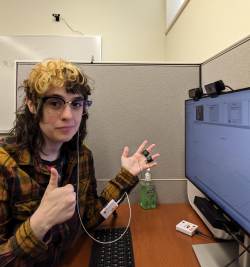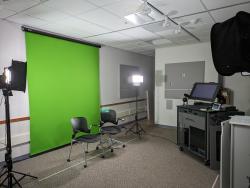Isenberg’s Berthiaume Behavioral Research Lab Enhances Research and Teaching
June 12, 2024

During the spring semester, Isenberg opened the Berthiaume Behavioral Research Lab, which offers eye tracking software, facial expression analysis, and galvanic skin response sensing technology—all of which will open up whole new dimensions of research and teaching tools to faculty and PhD candidates interested in measuring human behavior. The lab is funded by the historic gift from Douglas ’71 and Diana Berthiaume, which was announced last year.
George Milne, associate dean of research and PhD programs and Edward D. Shirley ’78 Endowed Professor of Marketing, who spearheaded the development of the lab, says the lab is an important advancement for Isenberg and will help increase the caliber of research produced by Isenberg researchers. “We will be the biggest behavioral lab in a business school in the Northeast with this place,” he says. “More and more research requires evidence that behavior has been changed, and this is one way to capture that. You can ask people what they think or what their attitudes are about things that they observe, but if you actually measure what their behavior reaction is, that’s much more credible and important.”
And this technology won’t just raise the profile and the credibility of the research coming out of Isenberg. It will also allow researchers to tackle new questions and add an extra layer of validity to study results for topics that have been difficult to accurately measure and assess in the past with more conventional research methods. Research by Verónica Martín Ruiz, assistant professor of marketing, is one example of this. It focuses on how underrepresented minority (URM) consumers in the U.S. make healthcare decisions, with the end goal of designing interventions that reduce the likelihood of URM consumers denying the accuracy of life-threatening health diagnoses. One thing that has been difficult for Ruiz in the past is that response bias tends to be high for people participating in research on this topic, meaning that people are likely to respond inaccurately for one reason or another. But this is where the Berthiaume Behavioral Research Lab can come in. “Collecting physiological data helps contrast what participants say with what they feel to obtain more accurate responses,” she says. “This is the best we can do without being in a doctor’s office when consumers receive the diagnosis.”

Inside the Lab
The Berthiaume Behavioral Research Lab features three types of research technologies. The first, eye tracking software, monitors and analyzes how and where a research subject looks at some sort of visual stimulus or stimuli, such as a specific object or a broader scene. Milne shared that one way this technology has been used thus far was to measure what factors make someone pay more attention to a particular product or brand. “We had subjects view two versions of a beverage can while we observed their reactions. We noticed that a multi-color can generated more arousal than a single-color can, and we could see how much time they spent looking at the brand depending on the can.” This could provide important information for marketers seeking to measure and increase brand awareness and recall.
Milne explained that the second type of technology in the lab, facial expression analysis, allows researchers to delve deeper into human emotions beyond just what people say they’re feeling. “Some people may say they’re feeling positive, but they may have some doubts and I think the facial expressions will uncover those doubts,” he says. “Or they’ll uncover mixed emotions, or show what element of a communication spiked the highest emotional response.”
Feng Qiu, assistant professor of management, recently designed a study in which the Berthiaume Behavioral Research Lab plays a key role. “My research question is how senior managers’ demonstration of hubris, overconfidence, or narcissism can impact people’s willingness to invest in the company,” he says. Study subjects would watch a series of videos where an actor portraying a CEO would discuss their company’s performance under a potential future financial crisis. “The CEO is either hubristic, overconfident, and narcissistic, or very realistic. So our plan is to ask them to watch those videos in the lab while we use the software to capture their facial expression and see what feelings we capture.”
The third technology available in the Lab is galvanic skin response software. Professor Milne explained that this software essentially measures stress. “There are certain situations where people face stress in the marketplace, in difficult decisions or things that they might not understand or something that’s new and beyond their capacity to handle,” he says. The software is especially useful because many people are reluctant to outwardly admit that they’re stressed because of social desirability factors. “People are saying, not me, I wasn’t stressed,” Milne says. “But dude, you were sweating. So you can actually say, ‘Yeah, you were stressed, your body did react that way.’ Technology is actually getting at a lot of truths that we weren’t able to uncover before.”